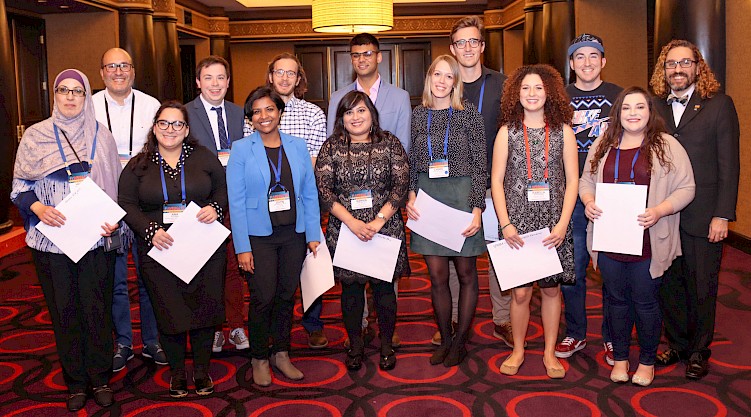The SfRBM Foundation was designed to foster and support SfRBM’s education, training, and research programs as well as fund new developments and opportunities in these areas.
In fact, since 1995, SfRBM has provided over $450,000 in Research Mini-Fellowships, Travel, and Young Investigator Awards to support scientists in early stages of their careers.

There are a number of ways to contribute, including one-time donations and Planned Giving. As 2019 comes to a close, please consider including the SfRBM Foundation in your giving plans.
Here are 5 reasons to donate to the SfRBM Foundation Today:
Please call us today at (317) 205-9482 to learn more about Planned Giving Opportunities. 
— Published
Categories: Free Radical Biology and Medicine, Education, SfRBM Trainee Council, Research, Redox Biology
Part 2 of 4 on “Exploring Careers in Industry” by SfRBM Nominations/Leadership Development Chair Anne Diers, Ph.D. (Dr. Diers on LinkedIn: https://www.linkedin.com/in/annerdiers/)
Looking for a job in academia versus elsewhere can be a very different process. LinkedIn is much more important in the non-academic setting. Make sure your LinkedIn page is current, professional, and thoughtful. You can also use LinkedIn to find out more about companies you're interested in, connect to people, network for informational interviews and/or positions (a personal introduction to a hiring manager can be very helpful), and look for position announcements.

Connect with SfRBM on LinkedIn at - https://www.linkedin.com/company/society-for-free-radical-biology-and-medicine/
Making the leap to industry can be very challenging. You need to target your search and be very active in it - your time will be better spent networking than just applying positions from the comforts of your home.
For the hiring manager, their biggest concern is that they’ll make the wrong decision on who to hire, ending up with someone who is not be able to accomplish the business objectives at hand. With that perspective, it becomes clear that the best way to get a job in industry is to allay those fears in the hiring manager. Or in other words, connect your skills to the needs listed in the job posting – be specific! That middle-author manuscript you’re on because you did a bit of confocal microscopy for the lab down the hall should become “demonstrated proficiency working in a collaborative team environment” on your resume. It also helps to have a personal introduction if possible. To do this, you’ll need to identify an opening, and then get in touch with someone who can help you get that introduction. Again, LinkedIn can help you get started; you can see who’s where and identify the connections you may not even know you already have. And don’t forget, you’ve got lots of networks to tap (not just those on LinkedIn) – including at SfRBM’s Annual Conference - because everybody knows somebody who knows somebody!
In part 3 of this series, Dr. Anne Diers will explore the topic “Resume ≠ Curriculum Vitae” In her series “Exploring Careers in Industry.”
— Published
Category: Education
Part 1 of 4 on “Exploring Careers in Industry” by SfRBM Nominations/Leadership Development Chair Anne Diers, Ph.D. (Dr. Diers on LinkedIn: https://www.linkedin.com/in/annerdiers/)
This might sound obvious, but “Industry” is a really broad term – so when you think of a job in industry, you’re actually talking about many huge sectors of science. The available jobs will be very different based on what you’re looking for. So you need to ask yourself a few questions to narrow in on the type of position you’re interested in. Do you want to be bench-facing? Would you like to manage a group of scientists? Do you love writing about science? Do your interests lie in product development, management, pharma, bio-tech, or instrumentation? These are obviously critical questions and you have to answer them for yourself. If the answers aren’t obvious, spend some time exploring different areas of non-academic science. myIDP at Science Careers is a very helpful tool in this respect  (myidp.sciencecareers.org/). In fact, there is an incredible wealth of information on Science Careers itself. Another good way to get a handle on what you're looking for is to talk to people doing these various jobs. Talk to your sales reps, see who they know and if they can connect you to people, set-up informational interviews to find out what people actually do in their jobs.
(myidp.sciencecareers.org/). In fact, there is an incredible wealth of information on Science Careers itself. Another good way to get a handle on what you're looking for is to talk to people doing these various jobs. Talk to your sales reps, see who they know and if they can connect you to people, set-up informational interviews to find out what people actually do in their jobs.
Looking at job sites for current openings can also help you refine your idea of an ideal position. First, you’ll see what opportunities are already open. But second, and more importantly, you’ll get an idea for what job titles match the job you want to do (and for which you have the necessary experience). You’ll start to develop a feeling for whether or not you want to be a Field Applications Scientist, or a Program Manager, or whatever, based on those descriptions. Then, when you find yourself in conversation with your sales reps, colleagues, or faculty, you can say to them “I’m looking for an entry-level [ideal position for you]. Have you heard of any openings for this type of job at [their illustrious company]?” This instantly gives you some credibility… and rightfully so. It means that you have done your homework, and you have a real idea of what you want to do.
In part 2 of this series, Dr. Anne Diers will explore the topic “Where do I want to work… and who already works there?” In her series “Exploring Careers in Industry.”
— Published
Categories: Education, SfRBM Trainee Council
By Luciana Hannibal, Ph.D.
Team success goes hand in hand with the professional development of its members. New employees are selected according to background education (know-how theory), previous accomplishments (know-how experience) and potential (know-how to grow). These important metrics help to recruit candidates who are best suited for the position, and capture them at a stage of high self-motivation and drive. Only a few however, will stand out for their achievements, even when the same selection process has been applied to all. Why? A pool of employees will choose to remain in a professional comfort-zone, meeting personal and team demands satisfactorily. Others will strive to further their professional development and to make a difference in the team. Some will go beyond and prepare themselves to lead their own teams in the future. Even after careful recruitment, a population of talented individuals may however derail from successful career development. A mismatch of talents and projects can hamper advancement regardless of individual mindset. Researchers in leading positions are expected to excel at understanding the scientific problem, providing new ideas and solutions, teaching and supervising, cooperating effectively with internal and external colleagues and recruiting copious amounts of extramural funding. Optimizing self-reliance of the team is thus crucial for individual and collective return on investment, and this involves aligning talents with projects. Team leaders must identify individual strengths to effectively assign project roles, and employees must be visible for their most valuable talents. Self-motivated employees, as they typically land in the new job, constitute an invaluable asset.

Here is a brief guide on how to blend projects with selected talent types:
— Published
Categories: Education, Redox Biology, Free Radical Biology and Medicine
To Experienced Mentors,
 My principal investigator (PI) helped me with my writing, the postdocs in lab taught me bench science, and my fellow grad students helped me better communicate my science. I’m going to be in charge of training an undergrad on a project which will be an extension of my dissertation work. I’m excited, and my PI thinks I am ready for this responsibility, but I don’t know if I am going to be good at training as this is my first time as a science mentor. Should I be worried?
My principal investigator (PI) helped me with my writing, the postdocs in lab taught me bench science, and my fellow grad students helped me better communicate my science. I’m going to be in charge of training an undergrad on a project which will be an extension of my dissertation work. I’m excited, and my PI thinks I am ready for this responsibility, but I don’t know if I am going to be good at training as this is my first time as a science mentor. Should I be worried?
Sincerely,
A Nervous New Mentor
Dear A Nervous New Mentor,
First off, congratulations on taking this leadership role in your lab. Training freshmen scientists is one of the most important steps in maintaining the success of not only individual research programs, but scientific progress in general. That being said, training a new lab member as a graduate student or even a postdoc for the first few times can be challenging because rarely will you have someone providing constructive criticism as you employ your own method of training.
Even though this is your first time in a training position, know that your PI trusts you at this point in your career to be able to handle this responsibility. This is not to say there won’t be speed bumps and some additional demands on your already busy lifestyle. But that is where you can utilize your mentors’ help. Never be afraid to ask for advice from your PI and other colleagues who have had the opportunity to train new lab members. Use their advice to mold your own personal training strategy, and over time with trial and error you can improve your mentoring strategy. Even seasoned investigators sometimes have to modify the way they teach based on the available resources and personal characteristics of the trainee.
So to answer your question, don’t be worried. Instead, utilize your skills as a scientist to be observant and know that some hardships and failures may come up that you will have to find solutions to implement.
Sincerely,
An Experienced Mentor (who is still learning a few tricks)
— Published
Categories: Education, Redox Biology